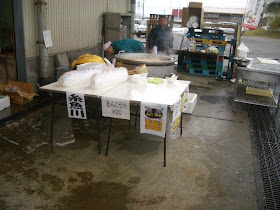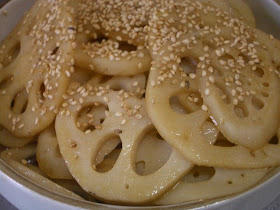On November 9, a festival was held at the local wholesale market where I live.
11月9日、地元の卸売り市場でお祭りがありました。


I bought three items there: Pork, assortment of sashimi, and cod roe.
3つ買い物をしました。豚肉、たらこ、刺身の盛り合わせです。
1-kg pork for 1,200 yen. Looks very nice and tender.
豚肉1キロ、1,200円。とても柔らかくて美味しそうです。

Cod roe, 1,000 yen. I bought the same cod roe as this one last year, and found it very good.
たらこ、1,000円。昨年もこれと同じたらこを買って、とても美味しかったです。

Assortment of sashimi, 2,000 yen. Six different fish: Buri (adult yellowtail), sea bream, squid, tuna, sweet shrimp, and octopus.
刺身の盛り合わせ、2,000円。魚は6種類:ブリ、タイ、イカ、マグロ、甘エビ、タコ。

This is the booth where I bought the cod roe:
たらこを買ったブースはここです。





This is the section where I bought the assortment of sashimi:
刺身の盛り合わせはこのコーナーで買いました。









Monkfish soup/アンコウ汁
They served monkfish soup for 500 yen per bowl. It contained a generous amount of flesh and liver.
Very generous indeed!
アンコウ汁を一杯500円で売ってました。身と肝がたくさん入っていました。
ホント、太っ腹です!






Monkfish hanging and cutting/アンコウの吊るし切り
One of the highlights of the festival was the monkfish hanging and cutting show.
お祭りの目玉の一つがアンコウの吊るし切りショーです。






Tuna Cutting/マグロ解体
Another popular event at the festival was the tuna cutting show. The event was held twice, first with a 63-kg bigeye tuna and second with a bluefin tuna of about 80 kg.
お祭りでもう一つの人気あるイベントはマグロの解体ショーです。このエベントは2回行われ、最初の63キロのメバチマグロ、2回目は80キロくらいの本マグロでした。









Other sections of the wholesale market:
They gave out large samples of bananas and pinapples in large quantities. Very, very generous in indeed!
卸売市場の他のコーナー:
バナナとパイナップルの試食、一個一個が大きくて、大量。本当に太っ腹です!










And, finally, this is the booth where I bought the pork.
最後に、豚肉を買ったのはここです。

For those of you who wish to know what the festival was like last year, please visit this
thread on eGullet.
去年のお祭りの様子を知りたい人は、eGulletのこの
スレッドを見て下さい。






















 For more information about ratios for seasonings, visit this thread on eGullet.
For more information about ratios for seasonings, visit this thread on eGullet.



















































